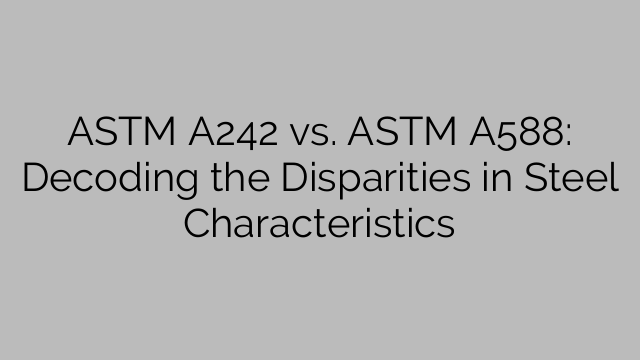ASTM A242 and ASTM A588 are two popular steel specifications used for weathering steel applications. While they may appear similar, there are distinct differences in their composition and characteristics that make them suitable for different applications. Understanding these disparities is crucial to make the right choice when selecting steel for outdoor structures.
Weathering steel, also known as corten steel, is a type of high-strength, low-alloy steel that develops a protective oxide coating when exposed to atmospheric elements. This coating acts as a barrier and prevents further corrosion or rusting of the steel. This unique property makes weathering steel ideal for outdoor structures like bridges, buildings, and sculptures.
ASTM A242 and ASTM A588 are both weathering steel specifications, but they differ in terms of their chemical composition and mechanical properties. ASTM A242 is a type of steel that contains copper, nickel, and chromium as alloying elements. These elements provide added corrosion resistance and enhanced mechanical properties, making it a popular choice for structural applications.
On the other hand, ASTM A588 is a high-strength low-alloy structural steel that contains added alloys like copper, nickel, and chromium. These alloys promote the formation of a protective oxide layer and provide added strength, making it suitable for applications in harsh weather conditions.
One significant difference between ASTM A242 and ASTM A588 is the thickness requirements. ASTM A242 has a maximum thickness limit of 4 inches, while ASTM A588 allows for thicker materials with a maximum thickness limit of 8 inches. This makes ASTM A588 a suitable choice for heavy-duty structural applications or when additional strength is required.
Another disparity lies in the mechanical properties of the two specifications. ASTM A242 has a minimum yield strength of 50 ksi (kilopounds per square inch) and a minimum tensile strength of 70 ksi. In contrast, ASTM A588 has a minimum yield strength of 50 ksi and a minimum tensile strength of 70 ksi, but it also has a higher specified minimum elongation requirement. This higher elongation requirement means that ASTM A588 can withstand deformation without breaking under tension, making it more ductile than ASTM A242.
When it comes to corrosion resistance, both ASTM A242 and ASTM A588 exhibit excellent resistance to atmospheric corrosion due to the formation of a tightly adhering protective layer of rust. However, ASTM A242 has better corrosion resistance in severe environments, such as coastal areas with high salt content or industrial areas with high levels of pollutants. In such conditions, the alloying elements in ASTM A242 provide additional protection against corrosion, making it a preferred choice.
In summary, while ASTM A242 and ASTM A588 are both weathering steel specifications, they differ in terms of their composition, thickness limits, mechanical properties, and corrosion resistance. ASTM A242 is better suited for severe environments with added corrosion resistance, while ASTM A588 provides additional strength and ductility, making it suitable for heavy-duty structural applications. Understanding these disparities is essential for selecting the appropriate steel grade to ensure long-lasting and resilient outdoor structures.

